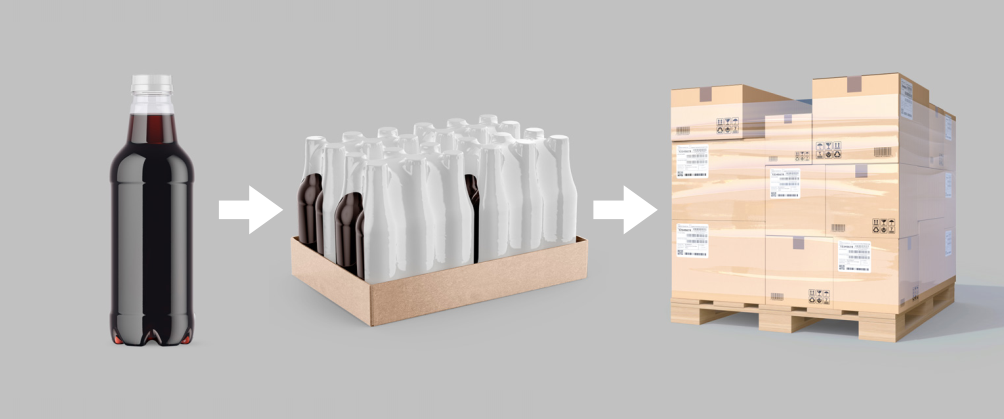Packaging plays a critical role in the protection, handling, and marketing of products across industries. The types of packaging used depend on the product's needs at various stages of production, distribution, and consumer use. To make sense of the different roles packaging plays, we can break it down into three main categories: primary, secondary, and tertiary packaging.

Primary packaging refers to the packaging that is in direct contact with the product itself. This is the first layer that holds and protects the product for consumer use. It is often designed to be visually appealing and informative to the consumer. Primary packaging serves the critical functions of containing, preserving, and protecting the product from contamination. Common examples include plastic and glass bottles for beverages, metal cans for food, plastic containers for medicines, or pouches for snacks.
Common Coding Technologies Used in Primary Packaging:
Primary packaging needs friction-resistant and tamper-proof marking technology, which usually requires high-precision inkjet or laser coding.
- Laser Marking: Used to etch durable, legible codes onto materials like glass, metal, or plastic, ensuring high quality even with frequent handling.
- Inkjet Printing: Including Continuous Inkjet (CIJ) printing and Thermal Inkjet (TIJ) printing, used for printing best-before dates, batch numbers, and barcodes, etc. directly on the packaging.
Secondary packaging is used to group a certain number of primary packages together, creating a Stock Keeping Unit (SKU). This packaging is not in direct contact with the product but plays an essential role in protecting the primary packaging, making it easier to handle and transport. It is also used to provide additional branding and marketing, as well as to aid in logistics and distribution. Examples of secondary packaging include corrugated cardboard boxes that hold multiple individual boxes of cereal or shrink-wrapped trays of bottled beverages.
Common Coding Technologies Used in Secondary Packaging:
Secondary packaging focuses on the consistency and readability of the coding, and usually uses self-adhesive labels or inkjet coding technology to meet batch processing requirements.
- Inkjet Printing Barcodes or Print & Apply Systems (self-adhesive labels) : Often used for SKU identification and to track products within a warehouse.
- RFID (Radio Frequency Identification): Increasingly used for more efficient inventory management and real-time tracking during shipping.
Tertiary packaging, also known as bulk or transit packaging, is designed for the bulk handling and transport of products. It groups multiple secondary packages into large, easily manageable units for storage and shipping, ensuring safe transport. Tertiary packaging is essential for preventing damage during long-distance shipping and large-scale distribution. Examples include stretch-wrapped pallets or large shipping containers that hold multiple smaller packages.
Common Coding Technologies Used in Tertiary Packaging:
The tertiary packaging conding needs to adapt to large sizes and complex environments. Heat shrink labels, pallet codes or large barcodes are commonly used, emphasizing the transportation tracking function.
- Thermal Transfer Overprinting (TTO) Labels or Large Barcode and QR Codes Labels: Used for bulk inventory management and tracking through the supply chain.
- Stretch Wrapping and Palletizing Inkjet Printing: To secure products and facilitate easier handling and transport tracking of large quantities.
The technologies used to code and mark packaging play a significant role in product identification, traceability, and overall logistics efficiency. Here's why packaging coding and marking are so important:
1. Regulatory Compliance: Many industries, particularly food and pharmaceuticals, are required to include product information, batch numbers, and expiration dates on packaging to comply with regulatory standards.
2. Traceability and Safety: Packaging codes, such as barcodes and QR codes, enable manufacturers, retailers, and consumers to track the product's journey from production to consumption. In the event of a product recall, having clearly marked packaging ensures swift identification and removal from the supply chain.
3. Logistics and Efficiency: Marking packaging helps with inventory management, order fulfillment, and warehouse tracking. This is especially crucial in large-scale distribution where real-time tracking and efficient handling are necessary.
4. Branding and Marketing: Packaging codes and marks are not only practical but can also be a part of a product's branding strategy. Packaging with unique codes or designs may be used for consumer engagement, loyalty programs, or tracking promotional campaigns.
5. Cost Savings and Reduced Errors: Clear and accurate coding reduces human error in the packing and shipping process, minimizing returns and damage during transportation. Efficient labeling also accelerates the overall supply chain process, reducing costs.
In the modern supply chain, primary, secondary, and tertiary packaging each have a distinct role. From the consumer-facing product to the bulk shipping unit, these layers of packaging ensure the protection, traceability, and efficient transportation of goods. Additionally, packaging coding and marking technologies such as inkjet coding, barcoding, and RFID systems are integral to meeting regulatory standards, optimizing logistics, and providing traceability. The importance of these technologies goes beyond simple labeling—they ensure consumer safety, operational efficiency, and even provide marketing opportunities.